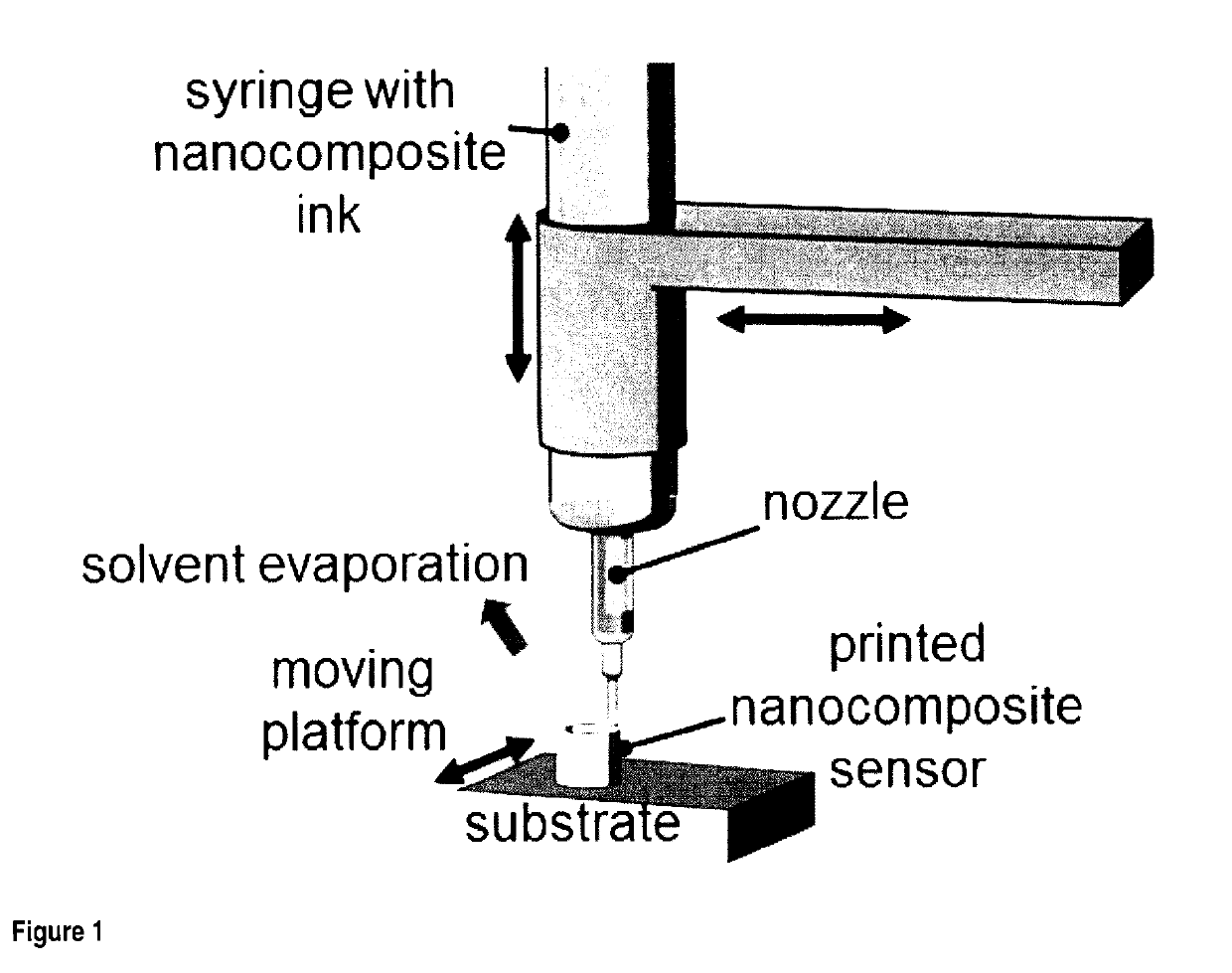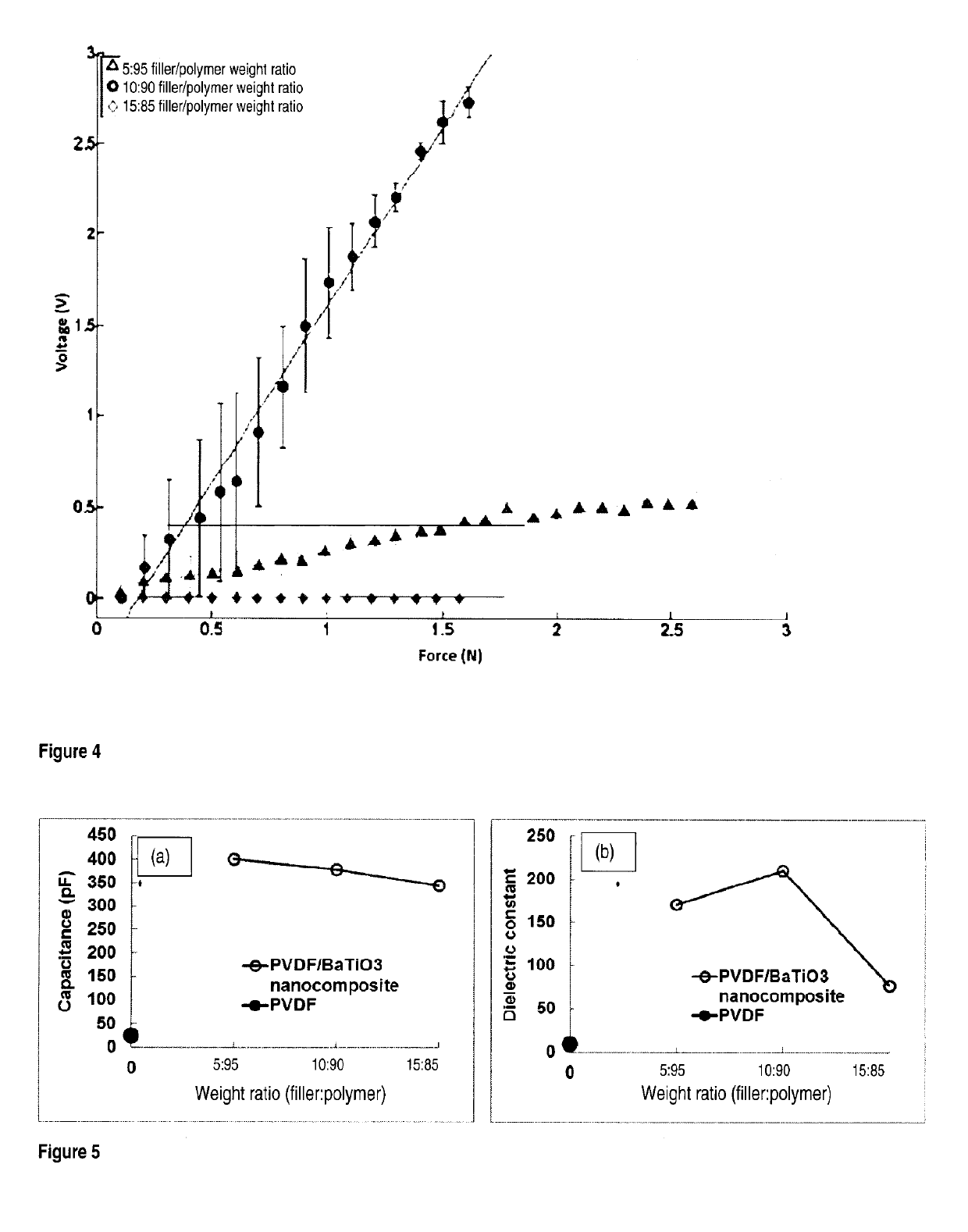Piezoelectric composite, ink and ink cartridge for 3D printing, bifunctional material comprising the piezoelectric composite, manufacture and uses thereof
- Summary
- Abstract
- Description
- Claims
- Application Information
AI Technical Summary
Benefits of technology
Problems solved by technology
Method used
Image
Examples
example 1
Piezoelectric Nanocomposite
1. Experimental Details
[0370]Piezoelectric nanocomposites were fabricated by mixing a filler with a polymer. Piezoelectric inks for 3D printing were then fabricated by mixing the piezoelectric nanocomposite in a mixture of solvents. 3D printed structures, including sensors, were then fabricated using the piezoelectric inks.
1.1 Fabrication of Piezoelectric Composites
[0371]A mixture of Barium titanate nanoparticles (BaTiO3; 99.9% purity, 100 nm; Nanostructured & Amorphous materials Inc.; 0.2 g) and PVDF (Sigma Aldrich, 2 g) was sonicated with DMF (Alfa Aesar™) for 2 h. The solution was then mixed in a high energy shaker ball-mill (SPEX SamplePrep™ 8000 Series Mixer / Mill™) at a rate of 1080 cycles per minute for 20 minutes. The number of zirconia balls was chosen to match the weight of the solution. The solution was dried in a vacuum oven at 60° C. for 12 h to remove all the DMF. This resulted in a piezoelectric nanocomposite with a filler:polymer weight rati...
example 2
Piezoelectric Sensors
2. Experimental Details
2.1 Printing Material Combination 1
[0383]A sensor was also fabricated using both a piezoelectric ink as well as a conductive ink for 3D printing.
[0384]The conductive and piezoelectric inks were co-extruded from a single syringe. Thus, it was important to have similar rheological properties for the two inks. Three different concentrations: 1.5, 3 and 6 g of BaTiO3 nanoparticles in 0.5 g of PVDF (for use in piezoelectric inks) and 0.1, 0.2 and 0.3 g of multi-walled carbon nanotubes (CNTs) in 0.5 g of PVDF (for use in conductive inks) were investigated. The mixtures were dissolved in 2 mL of DMF, 3 mL of acetone, and 0.3 mL DMSO to form printable inks. The inks were meticulously filled into a 3 mL syringe half / half longitudinally as can be seen in FIG. 8. Similarity in the viscosities help avoid intermixing between the fluids. Comparatively larger extrusion nozzle diameters were chosen in order to obtain a near laminar flow to avoid any turbu...
example 3
Coextrusion Printing
Solvent-Cast 3D Coextrusion Printing
[0401]Various structures were printed by coextrusion printing of an ink containing 10 wt. % BaTiO3 nanoparticles in a solution of PVDF (0.34 g / mL) in DMF and acetone solvents together with a silver ink. The silver ink and the coextrusion process were those described in Example 2. The printing parameters were:[0402]nozzle diameter 840 μm,[0403]extrusion pressure=0.04-0.2 MPa, and[0404]speed=2-3 mm s−1.
[0405]The structures printed: conformal sensors on a hemisphere, spanning filaments, vertical pillar and whiskers, are shown in FIG. 17.
[0406]Furthermore, piezoelectric filaments were printed in a similar manner except that no silver ink was used.
Mechanical Properties of the Coextruded Filaments
[0407]Uniaxial tensile tests (Insight electromechanical testing machine), evaluated the Young's moduli, strength and strain at break of the filaments of FIG. 17(b) as well as the above piezoelectric filaments. The tests were performed at a s...
PUM
| Property | Measurement | Unit |
|---|---|---|
| Mass | aaaaa | aaaaa |
| Weight ratio | aaaaa | aaaaa |
| Viscosity | aaaaa | aaaaa |
Abstract
Description
Claims
Application Information
 Login to View More
Login to View More - R&D
- Intellectual Property
- Life Sciences
- Materials
- Tech Scout
- Unparalleled Data Quality
- Higher Quality Content
- 60% Fewer Hallucinations
Browse by: Latest US Patents, China's latest patents, Technical Efficacy Thesaurus, Application Domain, Technology Topic, Popular Technical Reports.
© 2025 PatSnap. All rights reserved.Legal|Privacy policy|Modern Slavery Act Transparency Statement|Sitemap|About US| Contact US: help@patsnap.com



